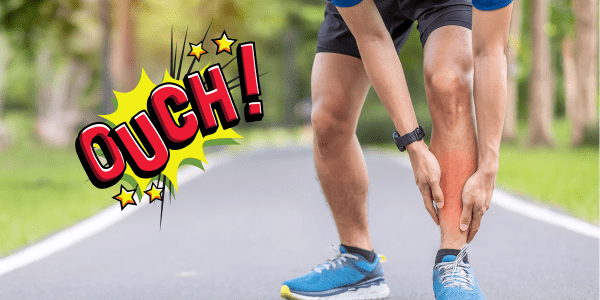How to Effectively Utilize Stretches for Shin Splints
When it comes to pain that can stop you in your tracks, shin splints definitely rank somewhere near the top. This debilitating pain can sideline you from exercise, sports, and an active lifestyle in a hurry. Many people simply wish for shin splints to go away, when in reality, if they utilized stretches for shin splints, they could more quickly and easily relieve their pain.
We’re going to take things a step further in this article. Not only are we going to dive into what exactly shin splints are, but what causes them, common stretches for shin splints, how to implement the stretches for shin splints, how to prevent them, and more!
Let’s dive in!
Disclaimer: This article is for informational purposes only and is not meant to treat or diagnose any condition. It is recommended that you speak with your doctor before engaging in an exercise program as well as if you feel you suffer from shin splints.
Table of contents

What are Shin Splints?
Horrible. That’s the only thing you need to know. But seriously, all jokes aside, shin splints (medically known as medial tibial stress syndrome) are a common condition characterized by pain along your shinbone.
Shin splints often plague athletes and individuals who engage in activities involving repetitive stress on the lower legs — think along the lines of long-distance runners.
Fortunately for you, if you fall into this camp, there are effective stretches for shin splints that can help alleviate your discomfort and may even help prevent future occurrences from sparking back up.
What’s the Cause of Shin Splints?
If you’ve had shin splints in the past, you probably would have done anything to get rid of them — and fast! Shin splints occur when excessive stress is placed on the muscles, tendons, and bone tissues in the lower leg, particularly the distal third of the tibia.
Repetitive activities like running, dancing, or jumping can cause inflammation and micro-tears in these structures, resulting in you experiencing pain and discomfort in your lower leg.
Factors such as poor footwear, overpronation, sudden increases in your activity level, and inadequate recovery time can contribute to the development of shin splints. The good news is that there are stretches for shin splints that can help prevent the condition as well as help alleviate the situation if you’re currently suffering from them.
Stretches for Shin Splints
While many people think the only thing to alleviate their pain is ice, stretches for shin splits can help considerably.
Related Article: Increase Flexibility with These Stretching Techniques
Below, you will find some stretches for shin splints that you can start implementing into your routine to help prevent shin splints as well as help you bounce back from painful shin splints that may have you sidelined from doing what you love. You’ll find detailed directions on how to complete each of the listed stretches for shin splints below each name.
1. Calf Stretches
- Stand facing a wall, approximately an arm’s length away.
- Place both hands on the wall at shoulder height.
- Step back with one leg while keeping the knee straight and the heel on the ground.
- Lean forward, allowing the front knee to bend slightly until you feel a gentle stretch in the calf muscle.
- Hold the stretch for 30 seconds.
- Repeat the stretch on the other leg.
2. Toe Raises
- Sit on a chair with both feet flat on the ground.
- Slowly raise your toes while keeping your heels on the floor.
- Hold this position for a few seconds.
- Lower your toes back down.
- Repeat this exercise for 10-15 repetitions.
- This is a great exercise to include in your leg day to hit the tibialis anterior. It can be done standing on a platform with your toes hanging off the front, and then you raise your toes up, flexing your tibialis anterior. Once this gets easy using your body weight, you can add some weights for more resistance.
3. Soleus Stretch
- Stand facing a wall, approximately an arm’s length away.
- Step one foot back, keeping both feet parallel.
- Bend the back knee slightly, and lean forward, pressing the back heel into the ground.
- You should feel a stretch in the lower part of your calf muscle.
- Hold the stretch for 30 seconds.
- Switch to the other leg and repeat the stretch.
4. Ankle Dorsiflexion Stretch
- Sit on the edge of a chair or a sturdy surface.
- Extend one leg straight in front of you, with the heel on the ground.
- Flex your foot by pulling your toes back towards your body.
- Use your hand to gently pull the top of your foot towards you until you feel a stretch in the front of your shin.
- Hold the stretch for 30 seconds.
- Switch to the other leg and repeat the stretch.
Remember, when performing these stretches for shin splints, it’s crucial to listen to your body and go at a comfortable level.
Related Article: Dynamic Stretching — The Vast Advantages and How to Apply Them
You want to avoid bouncing or jerking movements, as they can lead to further injury and pain. It’s recommended to perform these stretches for shin splints after a workout or physical activity when your muscles are warmed up, and there is good blood flow to the area.
Additionally, combining stretches for shin splints with other techniques like foam rolling, massage guns, icing, and strengthening exercises can further aid in the recovery and prevention of shin splints.
How to Utilize Stretches for Shin Splints
To maximize the benefits of stretching for shin splints, it’s essential to incorporate them into a well-rounded recovery routine. Below are some tips that you can follow to achieve the best results possible from your stretches for shin splints.
- When the muscles are warmed up effectively, perform these stretches for shin splints after a workout or physical activity.
- Aim to complete two to three sets of each of the stretches for shin splits mentioned, following the recommended hold time or the number of repetitions.
- Combine your stretches for shin splints with other recovery methods, such as foam rolling, massage guns, and icing, for better results.
- Gradually increase the intensity and duration of your stretches for shin splints over time.
Who Typically Suffers from This Condition and Can Benefit from Stretches for Shin Splints?
Shin splints are common among athletes involved in high-impact activities, such as runners, dancers, and even the most hardcore and elite military personnel. But overall, it can affect anyone, such as those who live an active lifestyle.

We should also mention that individuals with certain risk factors are more prone to developing shin splints and may need to implement stretches for shin splints. These factors include flat feet, overpronation (inward rolling of the foot during movement), inadequate footwear, sudden changes in training intensity or duration, and inadequate recovery time between workouts or training.
Preventing Shin Splints
Prevention is key to avoiding the pain and inconvenience of shin splints. Below are some preventive measures to consider:
- Gradually increase the intensity and duration of physical activity to allow the body to adapt.
- Ensure proper footwear that offers good arch support and cushioning.
- Incorporate strength training exercises that target the lower leg muscles.
- Maintain a balanced training routine with rest days to allow for proper recovery.
- Consider cross-training activities to reduce the repetitive stress on the lower legs.
- Listen to your body and address any pain or discomfort promptly.
- Utilize stretches for shin splints and other recovery methods to help prevent the condition.
The Takeaway
Shin splints can be a real pain in the butt — err, shins — to athletes and individuals engaged in physical activities. However, with the proper knowledge and approach, it is possible to manage and prevent this condition effectively.
By incorporating specific stretches for shin splints into your recovery routine, understanding the risk factors and potential causes, and adopting preventive measures, you can minimize the occurrence of shin splints and continue competing, performing, and working hard while staying pain-free. Do whatever you can to keep your shins healthy!


*Disclosure: This article may contain affiliate links or ads, which means we earn a small commission at no extra cost to you if you make a purchase through these links. These commissions help support the operation and maintenance of our website, allowing us to continue producing free valuable content. Your support is genuinely appreciated, whether you choose to use our links or not. Thank you for being a part of our community and enjoying our content.
PLEASE CONSIDER SHARING THIS ON YOUR SOCIAL MEDIA TO HELP OTHERS LEARN MORE ABOUT THIS TOPIC.





